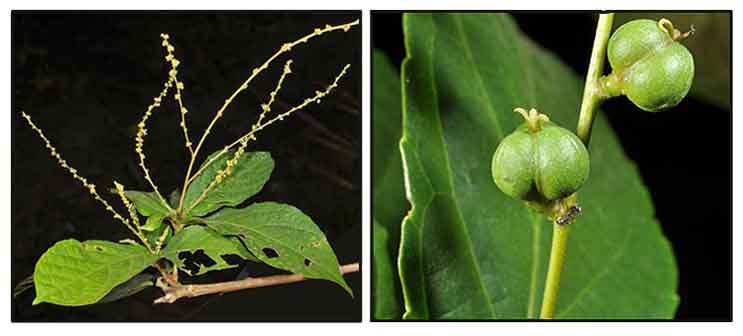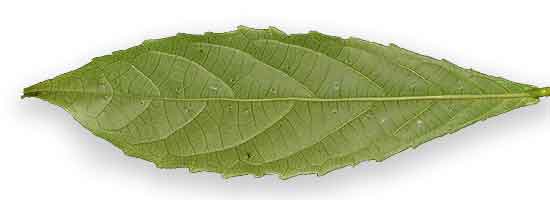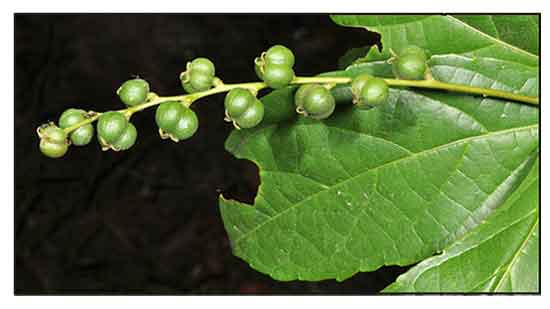
Family • Euphorbiaceae
Tayan
Makabangon
Alchornea rugosa (Lour.) Müll.Arg.
ALCHORN TREE
Foo tsa
| Scientific names | Common names |
| Adelia glandulosa Blanco | Aguyui (Tag.) |
| Alchornea hainanensis Pax & K. Hoffm. | Banauli (S.L.Bis.) |
| Alchornea hainanensis var. glabrescens Pax & K. Hoffm. | Gasugasi (Sul.) |
| Alchornea hainanensis var. pubescens Pax & K. Hoffm. | Gaugau (C.Bis.) |
| Alchornea javanensis (Blume) Müll.Arg. | Halum (Sul.) |
| Alchornea javanensis (Blume) Backer & Bakh.f. | Kanauai (Tag.) |
| Alchornea petalostyla Airy Shaw | Limo (Tagbanua) |
| Alchornea pubescens Merr. | Malambingan (Sul.) |
| Alchornea rugosa (Lour.) Müll.Arg. | Makabangon (Tag.) |
| Alchornea rugosa var. macrocarpa Airy Shaw | Samburagat-bukid (Tagbanua) |
| Alchornea rugosa var. pubescens (Pax & K. Hoffm.) H.S.Kiu | Tayan (Tag.) |
| Aparusthmium javanense (Blume) Hassk. | Alchorn tree (Engl.) |
| Aparusthmium javanicum Baill. | Rugosa alchornea tree (Engl.) |
| Cladodes rugosa Lour. | |
| Conceveiba javanensis Blume | |
| Conceveiba latifolia Zipp. ex Span. | |
| Croton apetalus Blume | |
| Tragia innocua Blanco | |
| Alchornea rugosa is an accepted species. KEW: Plants of the World Online | |
| Other vernacular names |
| BORNEO: Tjotjok kilik. |
| CELEBES: Umbana. |
| CHINA: Foo tsa. |
| JAVA: Kibewok, Ki-leat, Kissengat, Singugu. |
| MOLUCCAS: NGOFA DOFU. |
| NEW GUINEA: Ara fatem. |
| SUNDANESE: Jasilin dial. |
| THAILAND / VIETNAM: Bo met, Cay soi giai, Cay muoi, Cay chua mot, Cay dat mot. |
| OTHERS: Boot. |
Constituents Properties Studies Availability |
April 2025
![]()
 |
| Â Â Â Â Â Â Â Â Â Â Â Â Â Â Â Â Â Â Â Â Â Â Â Â Â PHOTOS / ILLUSTRATIONS |
| IMAGE SOURCE: Euphorbiaceae : Alchornea rugosa / Flowering twig / Copyright © 2013 by P B Pelser & J F Barcelona (contact: pieter.pelser@canterbury.ac.nz) [ref. DOL64231] / Non-Commercial Use / Image modified / Click on image or link to go to source page / Phytoimages.siu.edu |
| OTHER IMAGE SOURCE: Euphorbiaceae : Alchornea rugosa / Abaxial view of leaf / Copyright © 2012 by P B Pelser & J F Barcelona (contact: pieter.pelser@canterbury.ac.nz) [ref. DOL52019] / Non-Commercial Use / Image modified / Click on image or link to go to source page / Phytoimages.siu.edu |
| OTHER IMAGE SOURCE: Euphorbiaceae : Alchornea rugosa / Fruiting leaf / Copyright © 2012 by P B Pelser & J F Barcelona (contact: pieter.pelser@canterbury.ac.nz) [ref. DOL64318] / Non-Commercial Use / Image modified / Click on image or link to go to source page / Phytoimages.siu.edu |
| OTHER IMAGE SOURCE: Euphorbiaceae : Alchornea rugosa / Fruits / Copyright © 2013 by P B Pelser & J F Barcelona (contact: pieter.pelser@canterbury.ac.nz) [ref. DOL64273] / Non-Commercial Use / Image modified / Click on image or link to go to source page / Phytoimages.siu.edu |
Additional
Sources and Suggested Readings |
• |
DOI: It is not uncommon for links on studies/sources to change. Copying and pasting the information on the search window or using the DOI (if available) will often redirect to the new link page. (Citing and Using a (DOI) Digital Object Identifier) |
| Â Â Â Â Â Â Â Â Â Â Â Â Â Â Â Â Â Â Â Â Â Â Â Â Â Â Â Â Â Â List of Understudied Philippine Medicinal Plants |
| Â Â Â Â Â Â Â Â Â Â Â Â Â Â Â Â Â Â Â Â Â New plant names needed The compilation now numbers over 1,500 medicinal plants. While I believe there are hundreds more that can be added to the collection, they are becoming more difficult to find. If you have a plant to suggest for inclusion, native or introduced, please email the info: scientific name (most helpful), local plant name (if known), any known folkloric medicinal use, and, if possible, a photo. Your help will be greatly appreciated. |
• |
 |

 Gen info
Gen info

